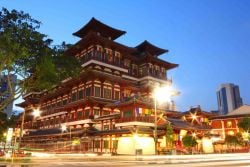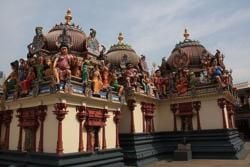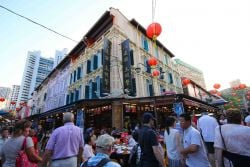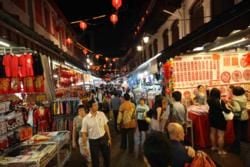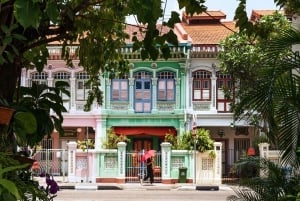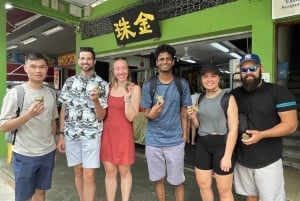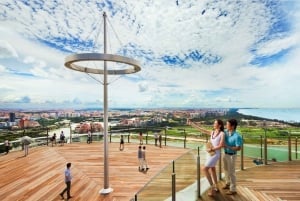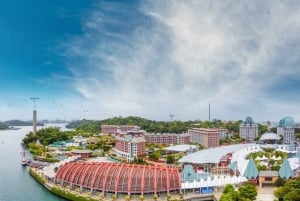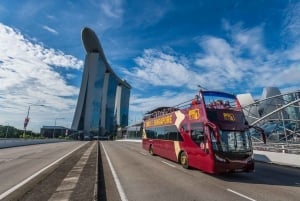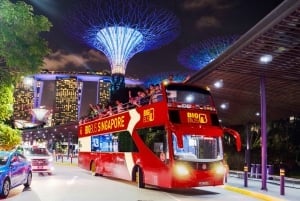Chinatown
Chinatown, one of Singapore’s most popular destinations, is a cultural enclave that delights the senses with a fusion of old and new. The streets in old Chinatown are ever busy, but especially so in the afternoon and evening hours, and during Chinese New Year and other important festivals such as Mid-Autumn Festival.
Delicacies from many regions of China are prepared in compact stalls. Colourful street sellers offer souvenirs, arts, crafts, decorations and every sort of knick-knack imaginable. Venerable temples tower above beautiful old shop houses. Exotic sights and smells abound in traditional Chinese medicine stores, with packets of dried fish, satchels of exotic mushrooms, and a whole spectrum of potent spices on display. Chinatown tea houses are wonderful for tastings, or a sweet break to sample the local kueh cakes. In Chinatown’s newer districts you’ll find chic shops, designer boutiques, hotels, restaurants and bars, at their liveliest during evenings and weekends.
Start your exciting journey on Temple Street, at the exit of the Chinatown MRT and right in the heart of it all. Take a walk and explore Trengganu, and Pagoda Street. The Chinatown Heritage Centre is a lovely museum, showcasing the history of Singapore’s Chinese community and featuring a souvenir shop and Heritage Restaurant.
Just a few metres away is Jamae Mosque, with its rare but lovely pagoda-like minarets. Built by Tamil Muslims from Southern India around 1826, it was Singapore’s first mosque, and reflects a strong Chinese influence.
Singapore’s Chinatown is nearly unique: it displays not only Buddhist temples, but Hindu and Muslim houses of worship as well.
The oldest and most important Hindu temple in Singapore is Sri Mariamman Temple, located on South Bridge Road. It offers a grand display of colourful statues and vivid ceiling frescoes. Perhaps its most impressive feature though is its entrance tower – called a gopuram – with six tiers adorned with delicate ornaments and figures of Hindu deities. The tiers and their sculptures diminish in size from the lowest to the highest, adding to the impression of great height. The temple is a centre for daily prayer, as well as for important festivals. Two of the most prominent celebrations are Timiti – a fire-walking festival held in October and November, and Thaipusam – a February festival commemorating the defeat of an evil demon.
Following the traffic down South Bridge Road, you will soon come to the superb Buddha Tooth Relic Temple and Museum, its architecture inspired by that of China’sTang Dynasty. According to Buddhist leaders, the temple is home to sacred relic – one of the Buddha’s teeth, enshrined within a 320-kg golden stupa or dome. The complex also houses a Buddhist cultural museum and a theatre where talks and films are presented.
Across the street, along Erskine Road, Ann Siang Road and Club Street mark the start of a more modern Chinatown, sporting eclectic cafes, quirky shops, splendid heritage restaurants and beautifully-designed boutique hotels. The area is known as Ann Siang Hill and is a popular after-work spot, with fine restaurants and fancy rooftop bars. On weekends, bars feature live music, and mixed crowds of locals, expatriates and visitors from around the world fill the streets with chatter and laughter.
Take the covered walkway from Ann Siang Road to Amoy Street, and you will find yet another important Buddhist temple: Thian Hock Keng Temple, built by Chinese immigrants to thank the Goddess of the Sea for a safe ocean passage. It is one of the oldest Hokkien temples in Singapore. Following traditional southern Chinese architectural style, the entire building is assembled without nails. It is a true masterpiece of stone, tiles and wood, displaying dragons, phoenixes and impressive sculptures.
Another popular and modern area of Chinatown is Duxton Hill, farther south and west along South Bridge Road, near Neil Road. Not much remains of the 1,800 nutmeg trees which once grew here, but the National Heritage Board has restored the beautiful shop houses and terrace houses that are now home to a vibrant restaurant and bar scene.
Take your time to discover Chinatown and immerse yourself in this colourful and lively centre of culture. Plan your trip for an afternoon, as most shops open around lunch time. Plan to have dinner in one of the street kitchens, or perhaps at one of the grand restaurants in the vicinity of Ann Sian Hill. Chinatown is an experience not to be missed – and you’re sure to come home with plenty of colourful photos to show family and friends!
Check out our video about Chinatown during the colorful and vibrant Mid-Autumn Festival:
Watch the video of Chinatown during Chinese New Year 2014 in Singapore: the festive Bazaar, the Opening Ceremony and the stunning street light-up of Chinatown.


